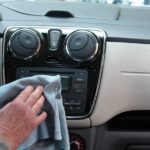Quick Navigation
Carbon monoxide is one of the most poisonous gases. Data from the Center for Disease Control (CDC) reveals that 430 people die, and 50,000 more get rushed to the emergency rooms due to carbon monoxide poisoning. But you can protect yourself from inhaling carbon monoxide.
Carbon monoxide results from the incomplete combustion of organic fuels such as gasoline, natural gas, oil, coal, and wood.
Carbon monoxide will rapidly accumulate when your car is left running in enclosed places such as the garage.

As you read this article, you will be able to know everything about carbon monoxide, how harmful it is, how long it takes for the engine of your car to produce a substantial amount of harmful carbon monoxide gas and many more.
What Happens When You Leave Your Car Running in the Garage for a Short Time?
When you leave your car running in the garage for a short time, carbon monoxide will build up.
Carbon monoxide accumulation can be so rapid and deadly within a very short time. For this reason, it is advisable not to leave your car running in the garage for even a shorter time.
Remember, you can do nothing to prevent your car from emitting carbon monoxide. Even if you have an engine with zero mileage, it will still emit carbon monoxide as long as it runs on fossil fuel.
However, there are modifications to the car engine and the exhaust system to eliminate and reduce carbon monoxide emissions.
With all these modifications, car engines still produce a substantial amount of carbon monoxide, which is harmful and deadly. In an enclosed place like a garage, the CO accumulates very fast.
According to the research conducted by CDC, A 5HP gasoline engine takes roughly 7 minutes to heat and produce life-threatening carbon monoxide.
After only 7 minutes, the concentration of carbon monoxide in the garage is adequate to claim lives.
Just imagine that it is only a 5HP, and an average car engine ranges between 100 to 200HP.
A standard car will take a very short time to produce a substantial amount of carbon monoxide, which can kill quickly.
Is It Safe to Leave Car Running in the Garage?
Leaving your car running in the garage is unsafe as this will cause carbon monoxide poisoning.
Inhaling carbon monoxide can leave you with a mild headache, nausea or even dizziness. But if it is severe, it can lead to brain damage or even death.
Carbon monoxide is a dangerous gas that is named a silent killer. Why silent killer? Because as you inhale it, it will not irritate your breathing system and has no distinctive smell.
So you cannot tell when you are inhaling it, but your body will respond as soon as it will start to accumulate in your system
When you inhale carbon monoxide, your blood will not be able to carry oxygen.
As the gas builds up in your respiratory system, it will affect areas that require oxygen to function, such as your heart and the brain.
The brain will automatically malfunction when it is not receiving adequate oxygen.
You will experience symptoms like dizziness, headache, and even nausea as this begins. As the gas accumulates in your system, it will damage your brain and cause death.
The carbon monoxide not only remains in your garage but will advance and spread into your house if your garage is attached to the house.
According to the study conducted by Air Infiltration and Ventilation Centre (AIVC), between 5 – 85% of carbon monoxide gets into your house if both the house and the garage are attached.
Once the carbon monoxide enters your house, it will diffuse as it dilutes into lower concentrations.
Such low concentrations will adequately trigger the carbon monoxide detectors in your house.
Such happens only to warn you of the higher concentration of the killer gas in your garage.
Is It Good Staying in a Garage With Your Car Running?
Try as much as possible to avoid staying for long in your garage with your car running. It would help if you stayed in your garage with the car running when you get in or out.
And in such a time, you must take the necessary precautions like ensuring adequate air circulation in the garage. It is, therefore, essential to have a garage with air vents and windows.
Remember that you are dealing with a killer gas that can cause serious health problems if not carefully handled.
Sitting in your garage with the running engine is like signing a death certificate and heading into the furnace. It will help if you avoid staying in your garage when your car’s engine is running.
Is It Good to Warm Up Your Car in the Garage?
Warming your car in the garage should never cross your mind. When you start the engine, it will produce much carbon monoxide compared to after the engine has picked up.
The first minute after igniting your car, the levels of carbon monoxide can rise to 80,000 PPM.
You will require warming your car because the engine is cold, but this is the most dangerous time to be around your car.
It is necessary to do it in an open place. Remember, everything is cold, including the catalytic converter, and therefore it will not be able to function effectively, resulting in high carbon monoxide emission.
The cause of high carbon monoxide emission when your engine is warming up is the high initial fuel mixture.
As the engine continues to run, the fuel mixtures lean out, and the catalytic converter warms up to start functioning.

Is It Advisable to Sleep in the Car With the Engine Running?
Avoid sleeping in the car when the engine is running, even if you close the windows.
The carbon monoxide fumes will still find their way inside the car through small gaps, which may put you into permanent sleep.
Sometimes the day might be long, and you might take a nap in the garage before switching off the engine when you get home.
Doing this is tempting, but walking out of the garage and napping in your bedroom is advisable.
When the engine runs, it compromises the air quality in your garage, and you might inhale carbon monoxide without realizing it.
A garage is a place that stores all kinds of car accessories and other chemicals. All the chemicals in your garage can emit harmful gases that can risk your health if they mix with the carbon.
Final Verdict
Cars emit high levels of carbon monoxide, and you should never leave the engine running in the garage.
A garage is usually a stuffy area with many accessories and chemicals stored. If your garage is attached to your house, the carbon monoxide emitted from your car will find its way into your house, triggering the CO detector.
When this happens, it means the carbon monoxide concentration in your garage is high.
Carbon monoxide is also known as a silent killer gas. It is odorless and never reacts with the respiratory system.
The moment you inhale it, it prevents vital body organs such as the brain and heart from receiving oxygen.
When such happens, you will feel dizzy, nausea and, in higher concentration, you can die.

With comprehensive experience in writing exceptional quality articles and blogs about cars and related stuff, Daniel is one of the finest bloggers and a hardcore car lover we have. He is an ASE certified technician with an across-the-board experience of 10 years in the industry. He could not help tinkering with anything he got his hands on from a young age, which led to his remarkable career in the automotive repair industry.
When he is not under any hood, you can find him on the water or in the woods to pursue his passion for hunting and fishing. He has been writing for multiple sectors and is a regular contributor to several publications.
He currently owns a Nissan 300ZX TT and a Pearl Yellow but plans to upgrade it to 550 HP. His favorites include the Koenigsegg CCX and Lamborghini Diablo 6.0 VT, but for him, the Ferrari 360 Spider is one of the sexiest cars that exists to date.
Being an avid world traveler, he has spent most of his time analyzing the automotive markets, latest technology, and local favorites to enhance his knowledge base. He is currently living in North Caroline, where it’s all about food and coffee and, of course, cars.







